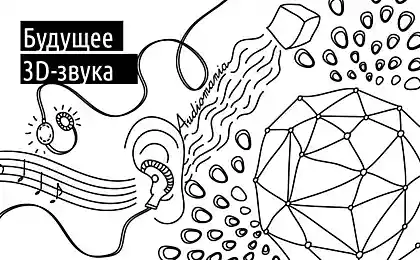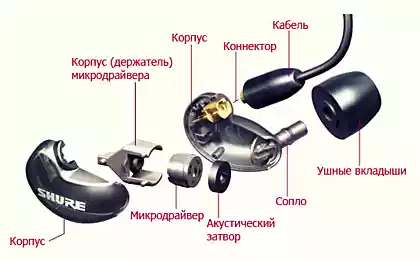The era of «post-fidelity» in the world of sound
Post-fidelity: a new era of music consumption and technological innovation. Daniel Huberman (Daniel Guberman), Journal of Contemporary Music Research, Issue 4, chapter 23, pp. 431-454. I>
Huberman divides the history of recorded music into two distinct periods: «fidelity era», the period that began with the inventions of Thomas Edison and complete the creation of the CD, and the era of «post-fidelity», which began with the creation of iPod. He believes that about 2001 music fans have come to appreciate the convenience of access, diversity of choice, personalization and security of your music collection better sound quality.
emblem of a bygone era "VK" can be called advertising Maxell, showing a rich man sitting in Recliners with a martini glass, looking at that, we feel physically as it dissolves in the music pouring out of the giant speakers .
The emblem of the era of «post-fidelity»: silhouettes of people, young men and women of different backgrounds and interests, dancing with their iPods.
In the era of "VK" articles and advertising focused on how was the "real" sound recorded on phonorecords and reproducible audio system. Stereo Hi-End class inevitably becomes more difficult and more expensive in the pursuit of sound depth and breadth of the dynamic range. Even the Walkman was originally touted as a device primarily qualitatively reproduce the sound. Huberman refers to an article from the New York Times 1980, extolling the "striking fact ...: pocket-sized device can play stereo moment." By the end of the twentieth century, however, even the most demanding audiophiles have ceased to expect revolutionary improvements in the quality of the recording and reproduction of music. Despite the fact that the CD was initially fed to the public as a carrier providing high sound clarity, in reality, its popularity is due to the convenience, the ability to switch tracks and no need to flip the disc from one side to the other and rearrange the needle.
MP3-format not immediately shaken the traditional values of music lovers. This format seems more "technical" interest for lovers of information technology, so the majority perceived the first generation of portable players, such as toys for geeks, not as a serious device for listening to music. The first iPod, but did not receive such support from the IT community. iPod was relatively an expensive device is compatible only with Mac computers and have not had any major technological advantages over competitors. None of the fans sound quality is not assumed that the appearance of this device symbolizes the end of the era of "dedication to quality." And yet attractive appearance and surprisingly simple user interface iPod helped elevate the MP3 format on top of popularity.
Over the next 10 years of iPod and similar devices have changed our relationship with music recordings. Now is the norm for us is that a lot of music is always at hand, that we ourselves create playlists and get access to their music libraries using attractive and intuitive interface. Moreover, MP3-oriented software and allow players to play music in random order. Some CD-Players can also play audio from a disc in a random order, but the possibility of random selection of the hundreds of thousands of songs - this is a new user experience. VK completely overshadowed by the convenience and selection as notices Huberman, even CD-disks in the era of their popularity often bought only to convert the recording with them in MP3-format. Moreover, elaborate and costly home audio system, which once formed around the player and amplifier class Hi-End, is now being developed to support a MP3-format.
Record companies do not immediately come to understand the era «post-fidelity». They tried to stop the advance of MP3, investing in the development of higher-quality formats such as SACD and DVD-A. About five years ago I wrote marketing materials on these formats, and it was not easy to enthusiastically describe products that I knew almost no one is interested. Technology companies such as Apple and Amazon, have benefited from a culture of «post-fidelity», while record companies are now experiencing hard times.
Today the community of music lovers make up most of the owners of home theaters and enthusiastic gamers. As these groups of users appreciate good sound, they also pay attention to the quality of the video content, accompanying a particular product, its appearance, and many other items. Huberman emphasizes that modern speakers like aspiring up poles, popular in home theater systems, developed primarily on the basis of aesthetic requirements for the final product rather than on the basis of their intended functionality. He also notes that even among audiophiles discussions are mainly around the particular music, not about the technologies that are used to play it. He studied the contents of the forum and found Audioholics following curious passage:
The most popular branch of discussion include the following: "the best female voice", "best male voice" and "20 albums that you do not, but in vain." In all these Trades users recommend each other albums, but rarely talk about the quality of the sound. Instead, they try to describe the characteristics of the music itself. Blockquote>
It's for the best. Musical technologies exist in order to play music, so it's better to focus on herself, not for the sake of the art technology.
The format of MP3, incidentally, gives far the worst sounding. The conclusion that MP3 - very low quality format stems from the widespread practice of listening to music from a laptop, tablet or mobile phone. If the last ten years have you ever been in a public transport, you probably saw a group of teenagers listening to music from your mobile without headphones. In the UK it is called in slang "sodkasting" (Eng. sodcasting , where «sod» means "moron, who spit on others "). Sodkasting annoying mostly adults - in 2006, the Mayor of London Ken Livingstone even tried to ban like listening to music in public places. But sharing music - a fundamental part of our social life, and we must understand that the kids will enjoy it for whatever they feel is appropriate. Some researchers have enough positive about sodkasting - music specialist Wayne Marshall ( Wayne Marshall ) calls this phenomenon the "culture ringtones» (treble culture ).
Huberman agrees that, while the era of "subversion of sound quality," and we have lost something at the same time we have gained a lot of opportunities of access to a huge music stores. While searching in the online music store or on sharing services, we accidentally find other songs with similar names. Huberman gives an example of search results, which were at the same time and "Rhapsody in Blue» (Rhapsody in Blue) George Gershwin, and Blue Öyster Cult. This type semirandom No search effort was the source of inspiration for the modern generation of musicians. For example, the eclectic recording performer and songwriter Janelle Monae ( Janelle Monáe ), on its words, just have to create the impression that your iPod plays the tracks in random order.
Era «post-fidelity» influenced the sound quality of modern pop music. Resourceful producers realized that the result of their work will most likely not be heard in the most optimal conditions, and to adjust the process of creating audio recordings. Hip-hop producers, in particular, create their tracks to listen to the realities of modern life: in cars, clubs, bustling streets, on buses and trains. Already in the 1990 LA hip-hop producers have acquired the habit of unfinished tracks to listen in the car. Modern pop music preference powerful synthesized bass and drums with more overtones . These sounds are played nice small column as harmony in the upper register gives the listener enough information so that he could (conceptually) to supplement its lower tones [ ie. user did not actually hear the lower tones, but he retained a sense of their presence i> - approx. pens.]. High, sharp synth sounds, punctuated by pauses, and justify their presence in modern compositions, as are well audible in noisy environments or when playing music with low quality speakers. Leaving the middle register is practically inaudible, music producers allow "embedded" in the surroundings filled with noise, the voices of the people hum of air conditioners and fans, the sounds of airplanes and other noises in the environment where we are constantly. Music era commitment to quality in such circumstances it is difficult to "keep the strike».
Like most of the technological changes, the era of «post-fidelity» has pluses and minuses. Let's go back to the two promotional images, which were discussed earlier in this article. Man with advertising Maxell enjoyed a lovely sound, but he does it at home, alone (away from his butler). People era overthrow sound quality dancing with their iPods in the context of society. Audiophiles depressing MP3 ringtones and culture, but it is - only evidence of social exchange and the formation of relationships, which are the true purpose of music.
Source: habrahabr.ru/company/audiomania/blog/218901/























